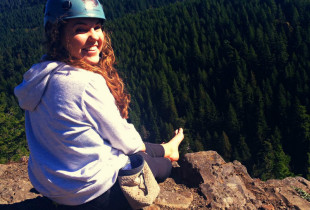By Chloe Rambo
It’s a life of rising early, slipping on your shoes and walking step by step to the next destination you’ll sleep. Map in hand, carrying all your possessions on your back with only a dirt-covered trail reaching for miles in front of you, all will agree it’s an adventure like no other.
The Pacific Crest National Scenic Trail currently holds the limelight following the success of thru-hiker Cheryl Strayed’s memoir, “Wild: From Lost to Found on the Pacific Crest Trail.” It is a hiking trail reaching from Mexico to Canada, snaking along 2,663 miles of California desert and mountain range, Oregon rains and meadows and Washington State evergreens. To some, it’s a challenge deemed unconquerable, to others, it’s a fantasy adventure more wild than not.
While it is difficult to judge exactly how many hikers start and finish the entire trail, the Pacific Crest Trail Association estimates 700-800 hikers begin, while only about 60 percent complete the 4- to 6-month long excursion. For hikers like Heather “Anish” Anderson, the deep back-country wilderness is a place of pure comfort – another home for the heart and the soul. “The wilderness is my home and my cathedral,” Anish says. It’s a place of meditation and inspiration, and there are few experiences as immersive as covering more than 2,000 miles on foot. “It is not a frightening place, it is one of immense beauty and experiencing it is one of the most wonderful parts of life.”
 2013 was an exceptional year for breaking records on the PCT. Anish shattered the self-supported trail record with a total time of 60 days, 17 hours and 12 minutes. She averaged 44 miles per day throughout her journey, despite constant elevation gains and losses and increasingly rough terrain.
2013 was an exceptional year for breaking records on the PCT. Anish shattered the self-supported trail record with a total time of 60 days, 17 hours and 12 minutes. She averaged 44 miles per day throughout her journey, despite constant elevation gains and losses and increasingly rough terrain.
“My journey on the PCT was a challenge, physically and mentally. This challenge is what made it such an adventure,” Anish said. “The question was always, ‘Can I do this again tomorrow?’”
That question is pervasive when hiking, but even more so when going out on a limb… solo. I spent three months this summer on the PCT as well, and even briefly met Anish as she was cruising through a popular hikers’ rest area known as Kennedy Meadows in southern California. I was new to the trail, having only hiked the 140 miles from the sun-blistered and dusty landscape of Tehachapi, California to Kennedy Meadows. My pale skin tanned bronze in the perfect form of my black Nike sports tank, I had finally become comfortable with a diet of peanut butter Clif bars and instant mashed potatoes, and had never heard of someone breaking a trail record – until I met Anish.
“People may think I am a natural athlete, the girl who played sports all through school,” Anish has said about her life and how fitness fit in. “The exact opposite is true. I was an overweight child, a bookworm who sat with her nose in an adventure book and daydreamed.”
It does take some athleticism to hike all day, every day, with a pack weighing from 30 to 60 pounds strapped to your back. But what it really takes is dedication and an endless sense of wonder. You don’t have to be a gym rat or marathon champion to conquer the trail, but the wish to empower yourself and set goals is a must. “It makes me ever so grateful to that chubby girl who dared to dream big, audacious dreams. I am even more thankful that she grew up to be a woman courageous enough to make those dreams reality,” she says.
Anish has a beautiful story of endurance and grit, but what makes it truly unique is her ability to inspire. The essence of Anish and author Cheryl Strayed is in you and me and every woman who has ever become seduced by the borderless, wide-open nature of the trail, the immense freedom and all it means.
“For women hiking solo the best piece of advice I can offer is this: Don’t be afraid. As long as you possess the basic skills of back country competency you will be fine. Go for it! Live your dreams!”

Tips for Hiking Solo:
While hiking in a group or with a buddy is considered to be the safest way to experience the great outdoors, hiking alone can offer an unparalleled experience for the mind and soul. Here are a few tips to stay safe in the wilderness, yet still enjoy your solo time.
Plan well. Gathering your chosen maps, compass and water source guide is an important first step, but actually knowing how to use them is vital. Before you head out, practice using your compass and map at your home – locating compass bearings in an unknown area can be difficult, but could save your life in an emergency. Know how much food and water you’ll need, and plan your hike accordingly. Also, always plan an extra meal or two.
Understand the importance of safe water treatment. Many of water sources on the PCT are shared with livestock and wild animals, so proper treatment is necessary to ensure a happy and healthy hike. Water pumps, drip filters, Aquamira purification tabs or even iodine or bleach are all valid ways to purify your water, but be sure to do your research on which method will work best for you. The Centers for Disease Control and Prevention say even though a water source may look pure, it probably isn’t. Be safe and purify every source you use.
Pay attention to your instincts. The trail is generally an incredibly happy and safe place, but it takes just one pernicious soul to ruin the experience for others. If your gut isn’t jiving with setting up camp next to a particular individual or group, then move on. Being on the trail is all about trusting and listening to yourself and reconnecting with those valuable instincts.
Practice meditation before you leave. One of the most disturbing things about being alone in nature is the quiet – it’s a thick, sometimes scary type of quiet unrecognizable to most. There won’t be any police sirens or traffic noises, no background music or “white noise” we often take such comfort in. Hiking alone can be really, truly quiet. Practicing meditation in a comfortable, quite place can help both your mind and your body find solace, rather than unrest, in such quiet.



